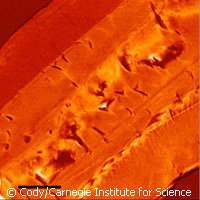Chemical structure of fossils revealed
A UK-US team of scientists has succeeded in revealing the chemical structure of ancient fossils with a powerful microscope. They discovered that even fossils dating from the Palaeozoic era, which spanned from around 542 to 251 million years ago, contained the polysaccharide chitin and structural protein. These materials are easily degraded by microorganisms. The scientists believe these findings, published in the journal Geology, could have major implications for our understanding of the organic fossil record. The team included Professor George Cody from the Geophysical Laboratory at the Carnegie Institution for Science in Washington, US and Professor Andrew C. Scott from the Department of Earth Sciences at Royal Holloway, University of London in the UK. The oldest molecular signature of chitin-protein complex was previously discovered in 25-million-year-old Cenozoic fossils, while remnants of structural protein were found in 80 million-year-old Mesozoic fossils. But in this latest study, scientists found relicts of protein-chitin complex in fossils of arthropods from the Palaeozoic era - a finding that no one would have ever imagined. Among other common features, arthropods have exoskeletons or cuticles. The outer portions of these cuticles are made up of a composite of chitin fibres that are embedded in a protein matrix. As chitin and structural protein are easily degraded by microorganisms, scientists presumed they would only be present in more recent fossils. While studying the fossil remains of a 310-million-year-old scorpion cuticle from the US state of Illinois and a 417-million-year-old eurypterid - an extinct scorpion-like arthropod, possibly related to horseshoe crabs - from Ontario in Canada, Professor Cody and his team discovered it wasn't true. Using sophisticated analytical instrument at the Advanced Light Source facility in the US, the researchers measured the absorption spectra of low-energy X-rays by carbon, nitrogen and oxygen in the fossils. These measurements were taken at a resolution in the order of 25 nanometres. The researchers showed that the majority of carbon, nitrogen and oxygen found in these fossils from the Palaeozoic era came from a protein-chitin complex. 'This study shows that fossil arthropod cuticle exists as a nanoscale composite of waxes and degraded, but still nitrogen-rich, chitin-protein complex,' the authors wrote. Not surprisingly, the protein-chitin material was somewhat degraded, either by chemical processes or partial bacterial degradation, according to the scientists. 'It is clear that the fossil macromolecule differs considerably from the initial chitin-protein composite of the modern cuticle,' the authors write. 'These differences can be interpreted as a result of extensive (but not complete) bacterial degradation and possibly subsequent diagenetic alteration,' they add. 'Extensive degradation of ester, amide, and glycosidic bonds likely destroyed much of the chitin-protein complex and freed fatty acids', while 'water elimination from chitin yielded unsaturated carbon that increases absorption intensity in the aromatic and/or olefinic region.' Professor Scott says the research would 'aid our understanding of the fossilisation process and this new technique allows us to reveal the chemical nature of the fossil without total destruction'. The vestigial protein-chitin complex may play a 'critical role in organic fossil preservation by providing a substrate protected from total degradation by a coating waxy substances that protect the arthropods from desiccation', he says.For more information, please visit: Carnegie Institution for Science:http://carnegiescience.edu/Royal Holloway, University of London:http://www.rhul.ac.uk/home.aspxGeology:http://geology.gsapubs.org/
Countries
United Kingdom, United States



